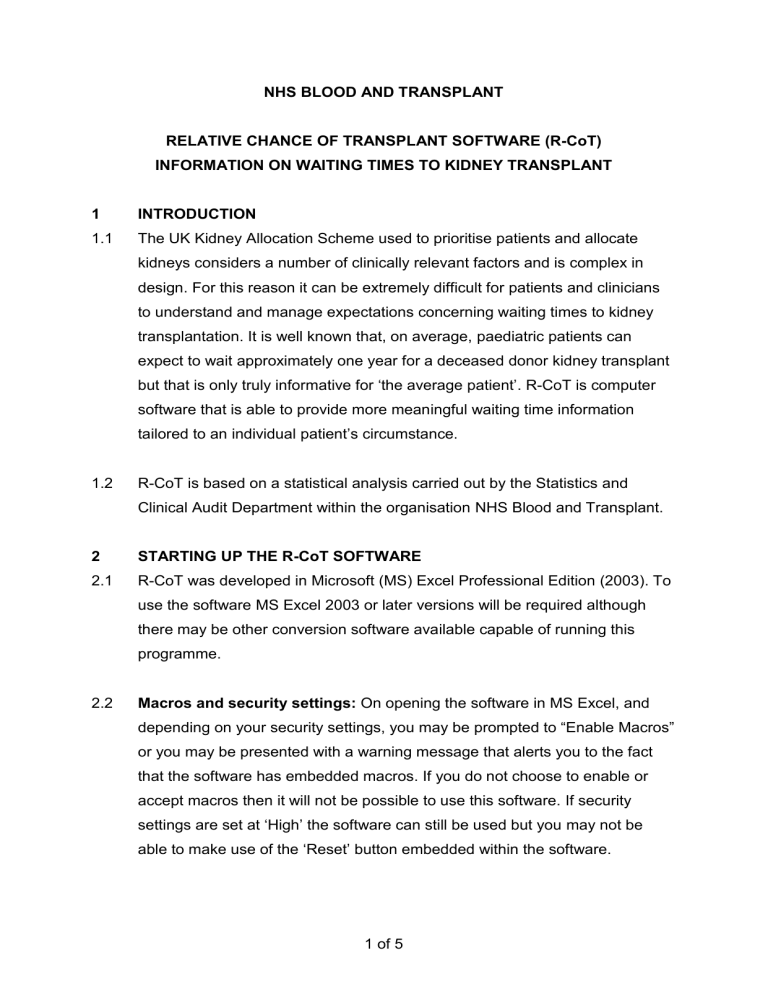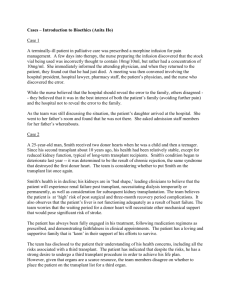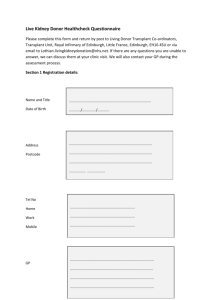RCoT Instructions for Use

NHS BLOOD AND TRANSPLANT
RELATIVE CHANCE OF TRANSPLANT SOFTWARE (R-CoT)
INFORMATION ON WAITING TIMES TO KIDNEY TRANSPLANT
1 INTRODUCTION
1.1 The UK Kidney Allocation Scheme used to prioritise patients and allocate kidneys considers a number of clinically relevant factors and is complex in design. For this reason it can be extremely difficult for patients and clinicians to understand and manage expectations concerning waiting times to kidney transplantation. It is well known that, on average, paediatric patients can expect to wait approximately one year for a deceased donor kidney transplant but that is only truly infor mative for ‘the average patient’. R-CoT is computer software that is able to provide more meaningful waiting time information tailored to an individual patient ’s circumstance.
1.2 R-CoT is based on a statistical analysis carried out by the Statistics and
Clinical Audit Department within the organisation NHS Blood and Transplant.
2 STARTING UP THE R-CoT SOFTWARE
2.1 R-CoT was developed in Microsoft (MS) Excel Professional Edition (2003). To use the software MS Excel 2003 or later versions will be required although there may be other conversion software available capable of running this programme.
2.2 Macros and security settings: On opening the software in MS Excel, and depending on your security settings, you may be prompted to “Enable Macros” or you may be presented with a warning message that alerts you to the fact that the software has embedded macros. If you do not choose to enable or accept macros then it will not be possible to use this software. If security settings are set at ‘High’ the software can still be used but you may not be able to make use of the ‘Reset’ button embedded within the software.
1 of 5
3 USER INSTRUCTIONS
3.1 Once opened, the screen should look like that shown in Figure 1 .
Figure 1: Opening screen shot
3.2 On the left hand side of the screen you will see a number of drop-down boxes.
A selection must be made in each drop-down box before a result will be shown. If you are unsure of the most appropriate response to select then you will still need to choose an option before a result will be shown. In such circumstances you can at least get a feel for the relative chance of transplant but it may not be as accurate as it could be. Equally some of the variables can change over time and this software can be used to understand their potential impact on anticipated waiting times.
3.3 To help select the correct information, further information on each of the variables listed can be found in the definitions section that follows. Once all the relevant information has been selected the software should present the results almost instantaneously. If you would like to reset all variables simply press the reset button.
2 of 5
4 DEFINITION OF INFORMATION REQUIRED
Matchability : Matchability is calculated from a standardised pool of 10,000 recent donors. From that pool the number of blood group identical donors that the patient is well or favorably HLA-mismatched is counted. This number is converted to a standardised score between one and ten and that number is used to group patients into one of three groups; easy, moderate or difficult to match.
Sensitisation: Please enter the appropriate group as defined by the standardised calculated reaction frequency percentage.
HLA-A homozygous : Sel ect ‘no’ if the patient is HLA-A heterozygous or ‘yes’ if the patient is HLA-A homozygous.
Patient ethnicity : Select white, Asian, black or other as appropriate.
Registration age : Recipient age at point of being actively listed onto the
National Kidney Transplant List.
3 of 5
5 INTERPRETING THE RESULTS DISPLAYED
5.1 An example of how the results are presented is shown in Figure 2 and an explanation of how to interpret the results is shown in paragraphs 5.2 to 5.4.
Figure 2: Example results
5.2 The Chart :
The chart indicates that, in patients that fit the selected criteria, around 59% are typically transplanted within three months of listing. However, and more importantly perhaps, 41% of this type of patient is typically not transplanted within three months of listing. As we move along the x-axis we can see that in all cases this patient type can expect to receive a DBD kidney transplant within two years of listing.
5.3 Percentiles
Percentiles are also shown in the bottom left corner of the screen. Three times are shown in years and months. In this example it is shown that 25%, of this patient type, typically receive a transplant within 1 month of listing, 50% within
2 months of listing and 75% within 5 months.
4 of 5
5.4 The results show 24 months only, why is that?
A statistical model based on real historical data is used to calculate the results shown. It is, to some extent, possible to predict what is likely to happen in the future based on what we have observed in the past. Because the vast majority
6 of paediatric patients receive a transplant within two years of listing it is not possible to provide robust and meaningful results beyond two years.
FURTHER INFORMATION
National Kidney Allocation Scheme
NHS Blood and Transplant 2014
5 of 5




